Self-Organizing Peer-To-Peer Middleware for Healthcare Monitoring in Real-Time
Abstract
:1. Introduction
- Healthcare monitoring and streaming middleware based on self-organizing middleware platform that can monitor care recipient regardless of where the caregivers are located without a central server.
- Supports peer-to-peer connections for self-organizing middleware platforms to provide healthcare monitoring and streaming services in a private network environment.
2. Related Research
2.1. Self-Organizing Middleware Platform and Self-Organizing Localized IoT Messaging Hub
2.2. NAT Traversal
2.3. Healthcare Monitoring
3. Concept of Proposed Monitoring and Streaming Service
3.1. Overview of Proposed Monitoring and Streaming Service
3.2. Concept of Streaming Service in a Public Network
3.3. Concept of Streaming Service in a Private Network
3.4. Concept of Monitoring Mobile App
4. Detail Design of Streaming Service
4.1. Streaming Service between Mobile App and SLIM Hub
4.2. Streaming Service between SLIM Hub in a Private Network
4.3. Streaming Service between SLIM Hub and Measurement Device
5. Implementation and Performance Evaluation
5.1. Test Environment
5.2. Evaluation of Service Start Time in a Public Network
5.3. Evaluation of Jitter
5.4. Connectivity Check in a Private Network
6. Discussion
7. Conclusions and Future Work
Acknowledgments
Author Contributions
Conflicts of Interest
References
- Catarinucci, L.; de Donno, D.; Mainetti, L.; Palano, L.; Patrono, L.; Stefanizzi, M.L.; Tarricone, L. An IoT-Aware Architecture for Smart Healthcare Systems. IEEE Int. Things J. 2015, 2, 515–526. [Google Scholar] [CrossRef]
- Basanta, H.; Huang, Y.P.; Lee, T.T. Intuitive IoT-based H2U healthcare system for elderly people. In Proceedings of the 2016 13th IEEE International Conference on Networking, Sensing, and Control (ICNSC), Mexico City, Mexico, 28–30 April 2016; pp. 2–7. [Google Scholar] [CrossRef]
- Abawajy, J.H.; Hassan, M.M. Federated Internet of Things and Cloud Computing Pervasive Patient Health Monitoring System. IEEE Commun. Mag. 2017, 55, 48–53. [Google Scholar] [CrossRef]
- Jeong, S.; Jo, H.; Kang, S. Fully Distributed Monitoring Architecture Supporting Multiple Trackees and Trackers in Indoor Mobile Asset Management Application. Sensors 2014, 14, 5702–5724. [Google Scholar] [CrossRef] [PubMed]
- Jeong, S.; Jo, H.; Kang, S. Self-Organizing Distributed Architecture Supporting Dynamic Space Expanding and Reducing in Indoor LBS Environment. Sensors 2015, 15, 12156–12179. [Google Scholar] [CrossRef] [PubMed]
- Jo, H.; Son, T.; Jeong, S.; Kang, S. Proximity-Based Asynchronous Messaging Platform for Location-Based Internet of Things Service. ISPRS Int. J. Geo-Inf. 2016, 5, 116. [Google Scholar] [CrossRef]
- Srisuresh, P.; Egevang, K. Traditional IP Network Address Translator (Traditional NAT). IETF; RFC 3022. 2001. Available online: https://tools.ietf.org/html/rfc3022 (accessed on 17 November 2017).
- Jeong, S.Y.; Jo, H.G.; Kang, S.J. Remote service discovery and binding architecture for soft real-time QoS in indoor location-based service. J. Syst. Archit. 2014, 60, 741–756. [Google Scholar] [CrossRef]
- Srisuresh, P.; Tsirtsis, G.; Akkiraju, P.; Heffernan, A. DNS Extensions to Network Address Translators (DNS_ALG); The Internet Society: Reston, VA, USA, 1999. [Google Scholar]
- Tran Thi Thu, H.; Park, J.; Won, Y.; Kim, J. Combining STUN Protocol and UDP Hole Punching Technique for Peer-To-Peer Communication across Network Address Translation. In Proceedings of the 2014 IEEE International Conference on IT Convergence and Security (ICITCS), Beijing, China, 28–30 October 2014; pp. 1–4. [Google Scholar]
- McKay, R.I.; Shin, J.; Hoang, T.H.; Nguyen, X.H.; Mori, N. Using compression to understand the distribution of building blocks in genetic programming populations. In Proceedings of the 2007 IEEE Congress on Evolutionary Computation, CEC 2007, Singapore, 25–28 September 2007; pp. 2501–2508. [Google Scholar]
- Srirama, S.N.; Liyanage, M. TCP Hole Punching Approach to Address Devices in Mobile Networks. In Proceedings of the 2014 International Conference on Future Internet of Things and Cloud, Barcelona, Spain, 27–29 August 2014; pp. 90–97. [Google Scholar]
- Riazul Islam, S.M.; Kwak, D.; Humaun Kabir, M.D.; Hossain, M.; Kwak, K.-S. The Internet of Things for Health Care: A Comprehensive Survey. IEEE Access 2015, 3, 678–708. [Google Scholar] [CrossRef]
- Farahani, B.; Firouzi, F.; Chang, V.; Badaroglu, M.; Constant, N.; Mankodiya, K. Towards fog-driven IoT eHealth: Promises and challenges of IoT in medicine and healthcare. Future Gener. Comput. Syst. 2018, 78, 659–676. [Google Scholar] [CrossRef]
- Wang, C.; Wang, Q.; Shi, S. A distributed wireless body area network for medical supervision. In Proceedings of the 2012 IEEE International Instrumentation and Measurement Technology Conference, Graz, Austria, 13–16 May 2012; pp. 2612–2616. [Google Scholar]
- Rawat, P.; Singh, K.D.; Chaouchi, H.; Bonnin, J.M. Wireless sensor networks: A survey on recent developments and potential synergies. J. Supercomput. 2014, 68, 1–48. [Google Scholar] [CrossRef]
- Khan, N.A. Real Time Monitoring of Human Body Vital Signs using Bluetooth and WLAN. Int. J. Adv. Comput. Sci. Appl. 2016, 7, 210–216. [Google Scholar]
- Laine, T.H.; Lee, C.; Suk, H. Mobile Gateway for Ubiquitous Health Care System Using ZigBee and Bluetooth. In Proceedings of the 2014 Eighth International Conference on Innovative Mobile and Internet Services in Ubiquitous Computing, Birmingham, UK, 2–4 July 2014; pp. 139–145. [Google Scholar]
- Passow, P.; Stoll, N.; Junginger, S.; Thurow, K. A wireless sensor node for long-term monitoring in life science applications. In Proceedings of the 2013 IEEE International Instrumentation and Measurement Technology Conference (I2MTC), Minneapolis, MN, USA, 6–9 May 2013; pp. 898–901. [Google Scholar]
- Rahmani, A.M.; Thanigaivelan, N.K.; Gia, T.N.; Granados, J.; Negash, B.; Liljeberg, P.; Tenhunen, H. Smart e-Health Gateway: Bringing intelligence to Internet-of-Things based ubiquitous healthcare systems. In Proceedings of the 12th Annual IEEE Consumer Communications and Networking Conference (CCNC), Las Vegas, NV, USA, 9–12 January 2015; pp. 826–834. [Google Scholar] [CrossRef]
- Shivakumar, N.S.; Sasikala, M. Design of vital sign monitor based on wireless sensor networks and telemedicine technology. In Proceedings of the 2014 International Conference on Green Computing Communication and Electrical Engineering (ICGCCEE), Coimbatore, India, 6–8 March 2014; pp. 1–5. [Google Scholar]
- Mora, H.; Gil, D.; Terol, R.M.; Azorín, J.; Szymanski, J. An IoT-Based Computational Framework for Healthcare Monitoring in Mobile Environments. Sensors 2017, 17, 2302. [Google Scholar] [CrossRef] [PubMed]
- Finet, P.; Le Bouquin Jeannès, R.; Dameron, O.; Gibaud, B. Review of current telemedicine applications for chronic diseases. Toward a more integrated system? IRBM 2015, 36, 133–157. [Google Scholar] [CrossRef]
- Hossain, M.S.; Muhammad, G. Cloud-assisted Industrial Internet of Things (IIoT)—Enabled framework for health monitoring. Comput. Netw. 2016, 101, 192–202. [Google Scholar] [CrossRef]
- Fanucci, L.; Saponara, S.; Bacchillone, T.; Donati, M.; Barba, P.; Sanchez-Tato, I.; Carmona, C. Sensing devices and sensor signal processing for remote monitoring of vital signs in CHF patients. IEEE Trans. Instrum. Meas. 2013, 62, 553–569. [Google Scholar] [CrossRef]
- Lim, S.; Oh, T.H.; Choi, Y.B.; Lakshman, T. Security Issues on Wireless Body Area Network for Remote Healthcare Monitoring. In Proceedings of the 2010 IEEE International Conference on Sensor Networks, Ubiquitous, and Trustworthy Computing, Newport Beach, CA, USA, 7–9 June 2010; pp. 327–332. [Google Scholar]
- Rushanan, M.; Rubin, A.D.; Kune, D.F.; Swanson, C.M. SoK: Security and Privacy in Implantable Medical Devices and Body Area Networks. In Proceedings of the 2014 IEEE Symposium on Security and Privacy, San Jose, CA, USA, 18–21 May 2014; pp. 524–539. [Google Scholar]
- Ondiege, B.; Clarke, M.; Mapp, G. Exploring a New Security Framework for Remote Patient Monitoring Devices. Computers 2017, 6, 11. [Google Scholar] [CrossRef]
- Kumar, P.; Lee, H.-J. Security Issues in Healthcare Applications Using Wireless Medical Sensor Networks: A Survey. Sensors 2012, 12, 55–91. [Google Scholar] [CrossRef] [PubMed]
- Park, Y.J.; Seong, K.E.; Jeong, S.Y.; Kang, S.J. Self-Organizing Wearable Device Platform for Assisting and Reminding Humans in Real Time. Mob. Inf. Syst. 2016, 2016, 1–15. [Google Scholar] [CrossRef]
- Kermarrec, A.; Triantafillou, P. XL peer-to-peer pub/sub systems. ACM Comput. Surv. 2013, 46, 1–45. [Google Scholar] [CrossRef]
- Wadhwa, R.; Mehra, A.; Singh, P.; Singh, M. A pub/sub based architecture to support public healthcare data exchange. In Proceedings of the 2015 7th International Conference on Communication Systems and Networks (COMSNETS), Bangalore, India, 6–10 January 2015; pp. 1–6. [Google Scholar]
- Hintjens, P. ZeroMQ: Messaging for Many Applications; O’Reilly Media, Inc.: Sebastopol, CA, USA, 2013; p. 493. [Google Scholar]
- Khattak, H.A.; Ruta, M.; Di Sciascio, E. CoAP-based healthcare sensor networks: A survey. In Proceedings of the 2014 11th International Bhurban Conference on Applied Sciences & Technology (IBCAST), Islamabad, Pakistan, 14–18 January 2014; pp. 499–503. [Google Scholar]
- Ghamari, M.; Janko, B.; Sherratt, R.; Harwin, W.; Piechockic, R.; Soltanpur, C. A Survey on Wireless Body Area Networks for eHealthcare Systems in Residential Environments. Sensors 2016, 16, 831. [Google Scholar] [CrossRef] [PubMed]
- Kim, B.-S.; Kim, K.; Kim, K.-I. A Survey on Mobility Support in Wireless Body Area Networks. Sensors 2017, 17, 797. [Google Scholar] [CrossRef] [PubMed]
- Chi, M.; Yang, J.; Liu, Y.; Li, Z. A Traffic Prediction Model for Self-Adapting Routing Overlay Network in Publish/Subscribe System. Mob. Inf. Syst. 2017, 2017, 8. [Google Scholar] [CrossRef]
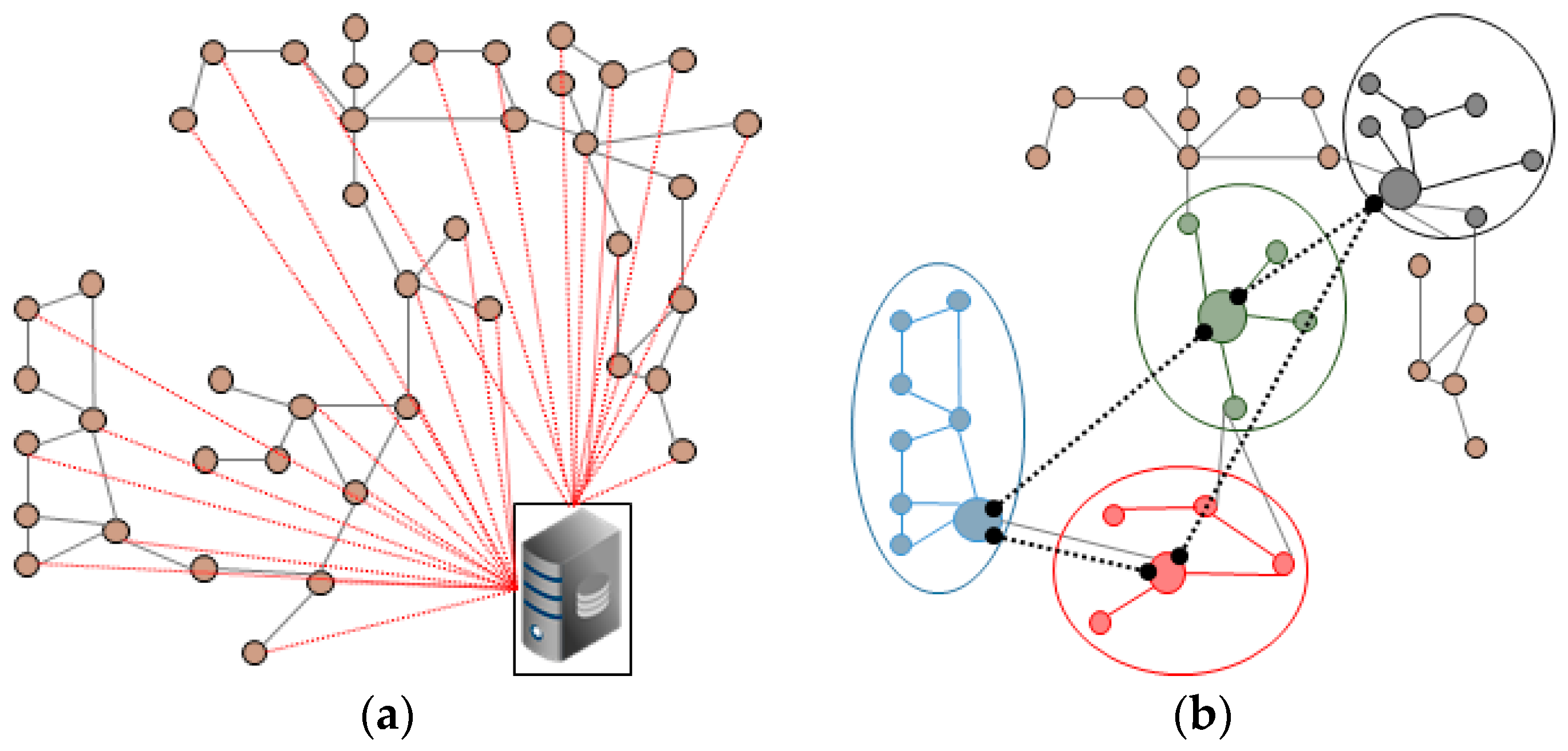
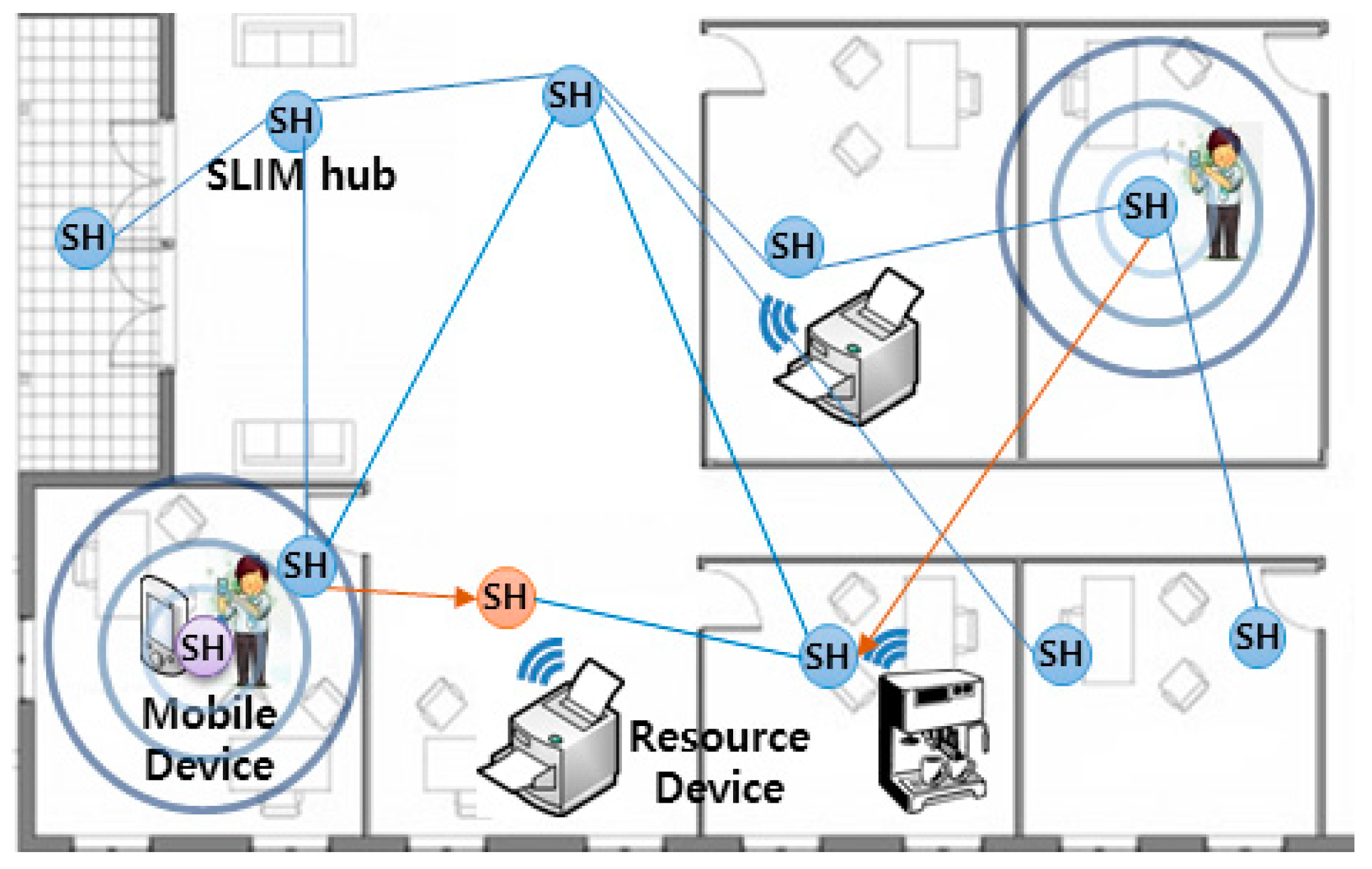

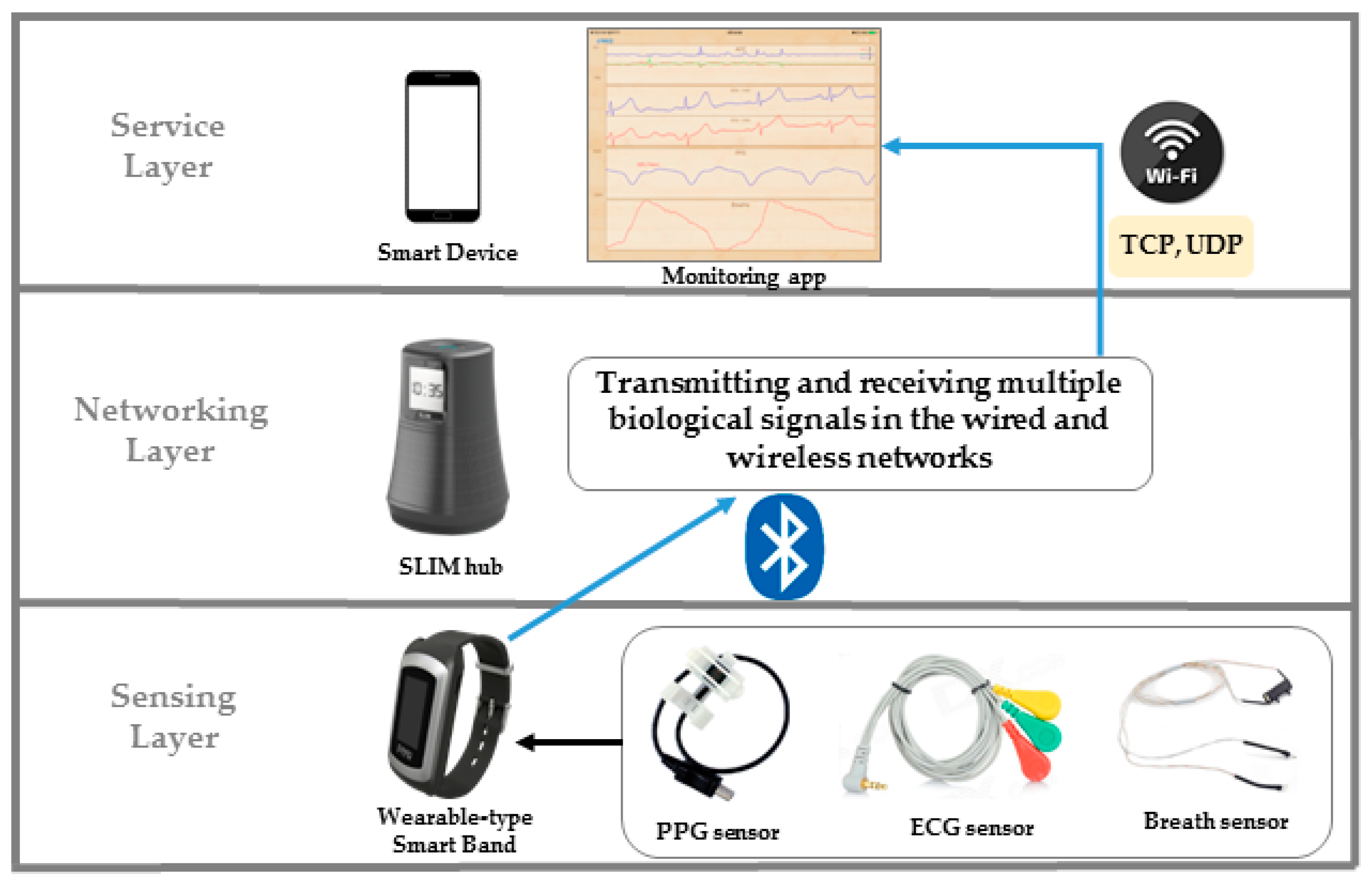
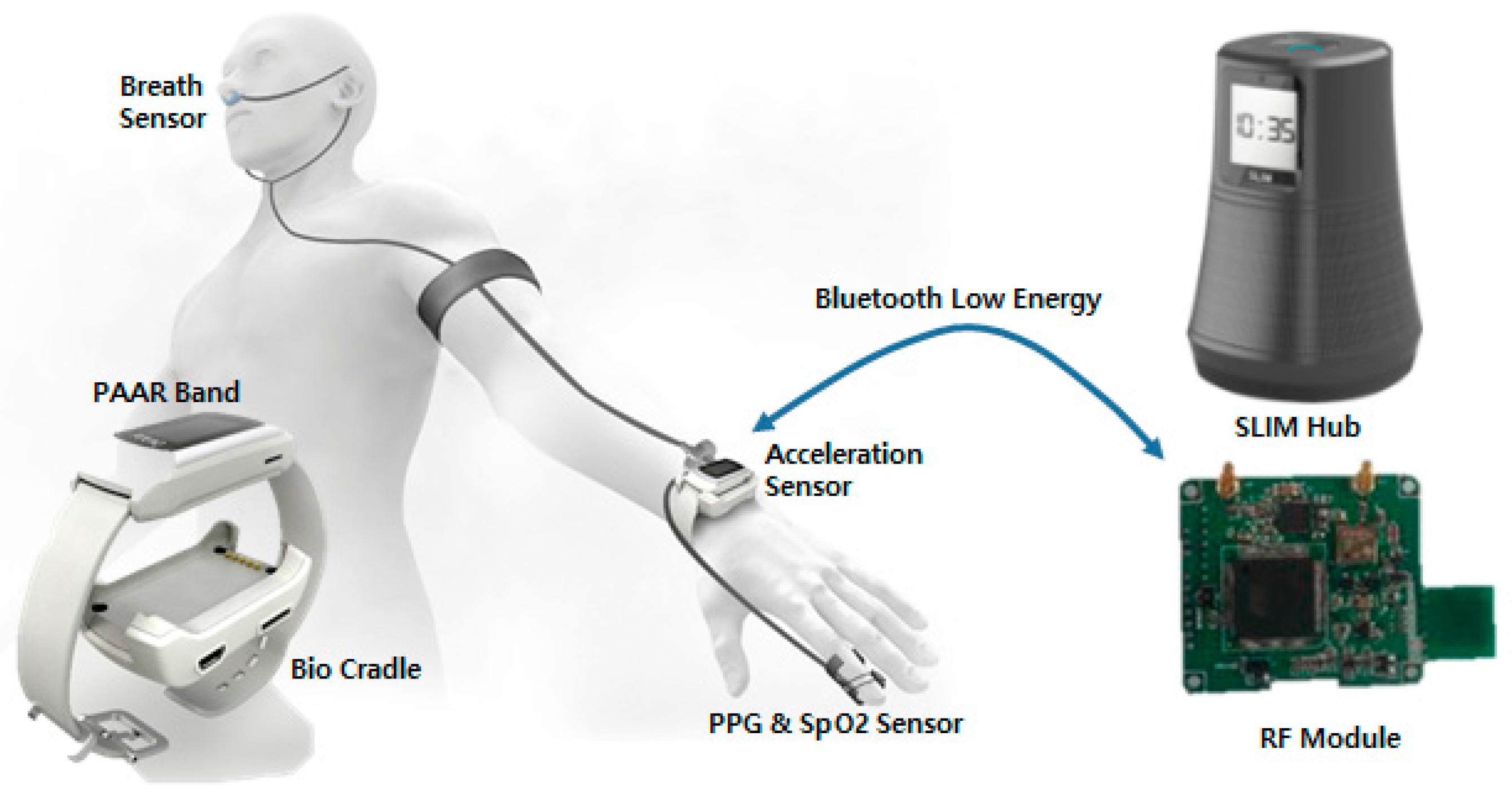

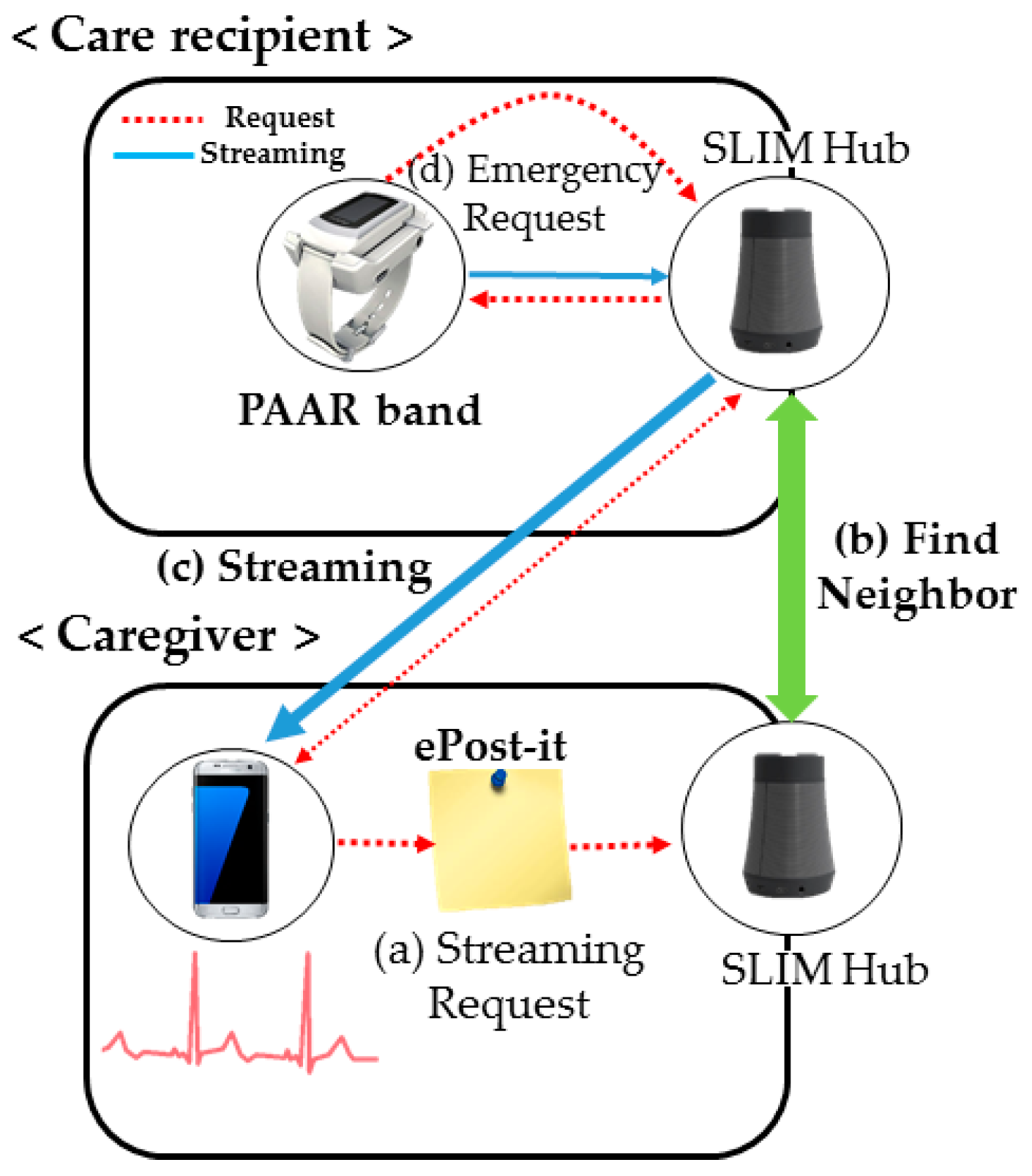
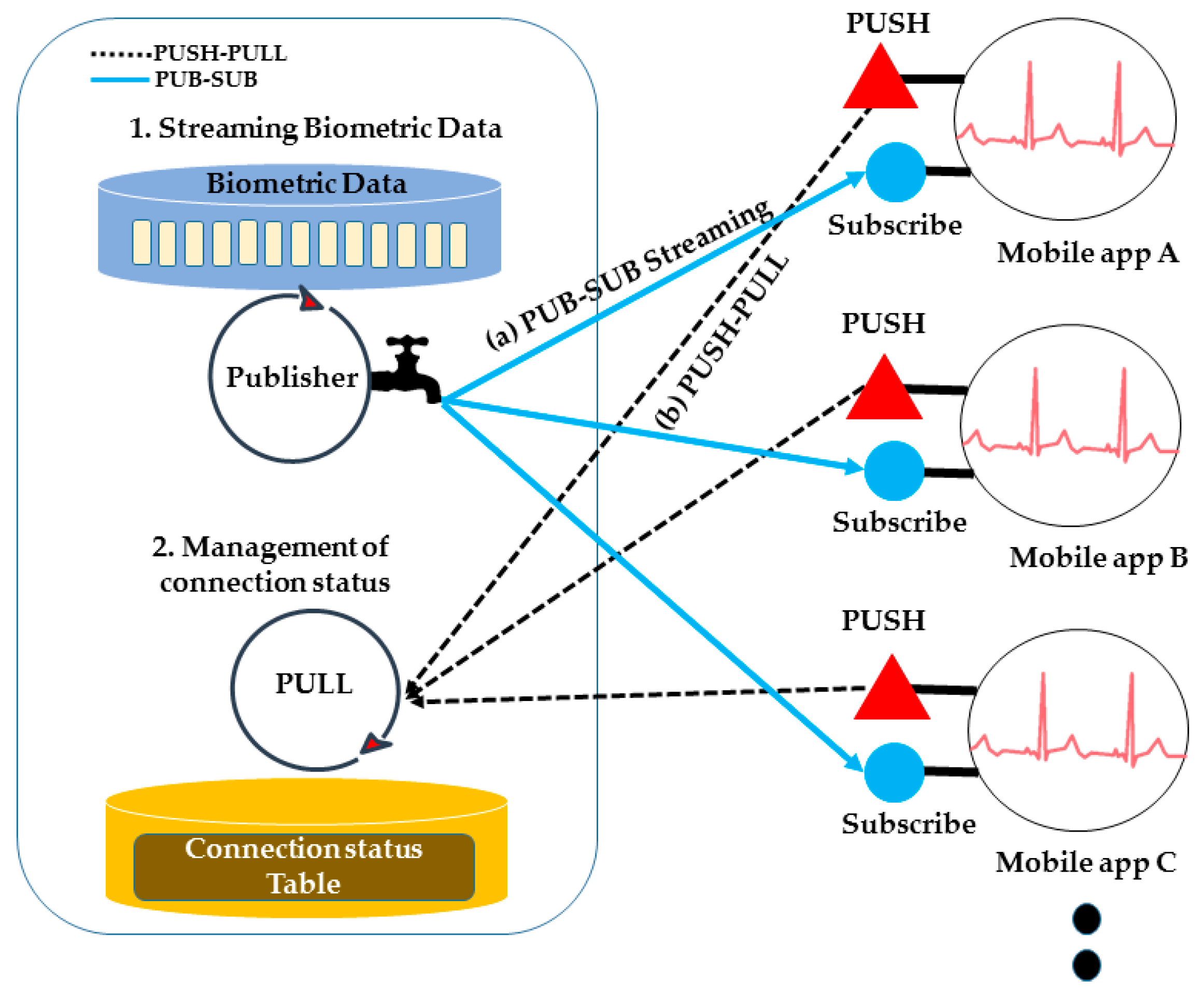
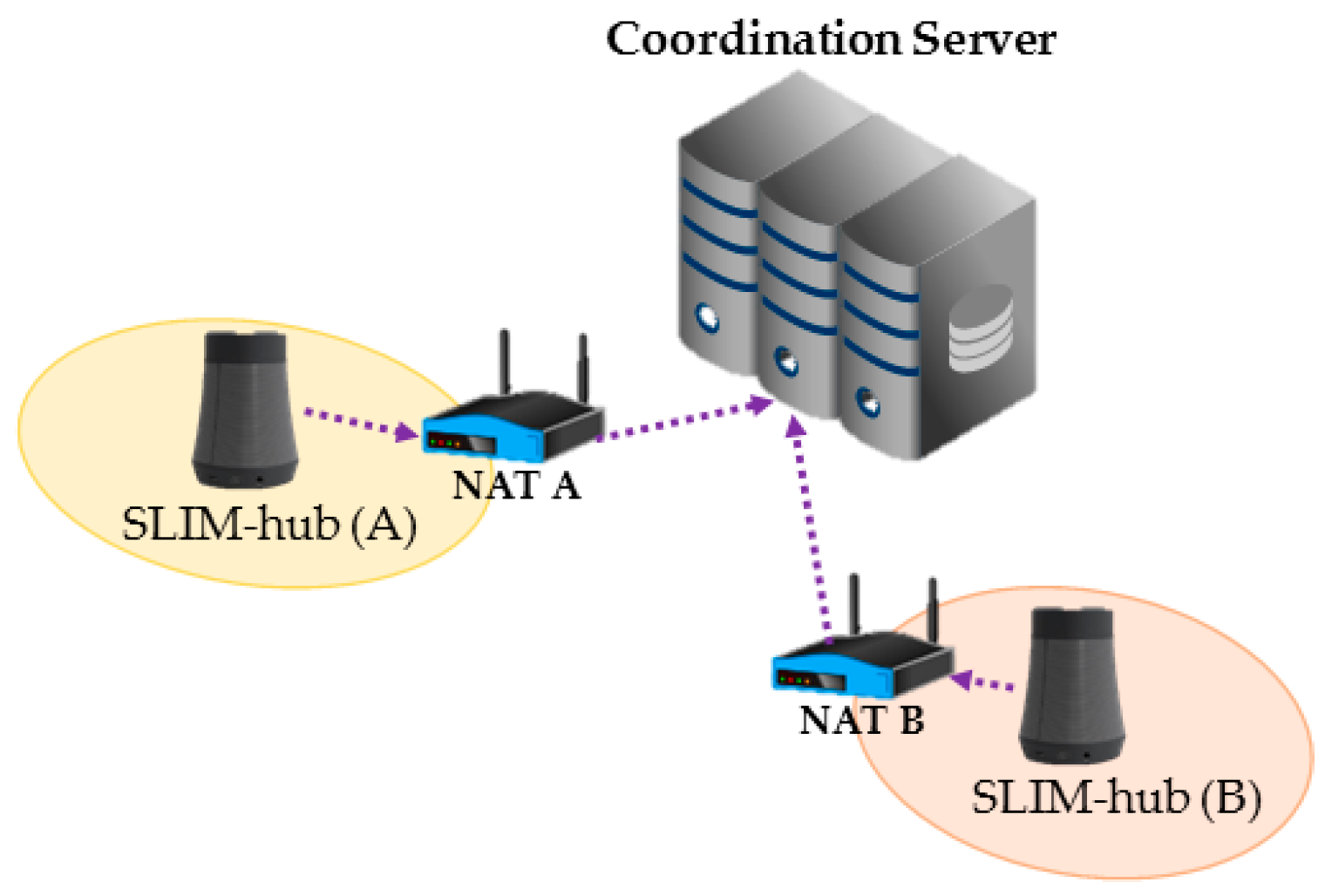


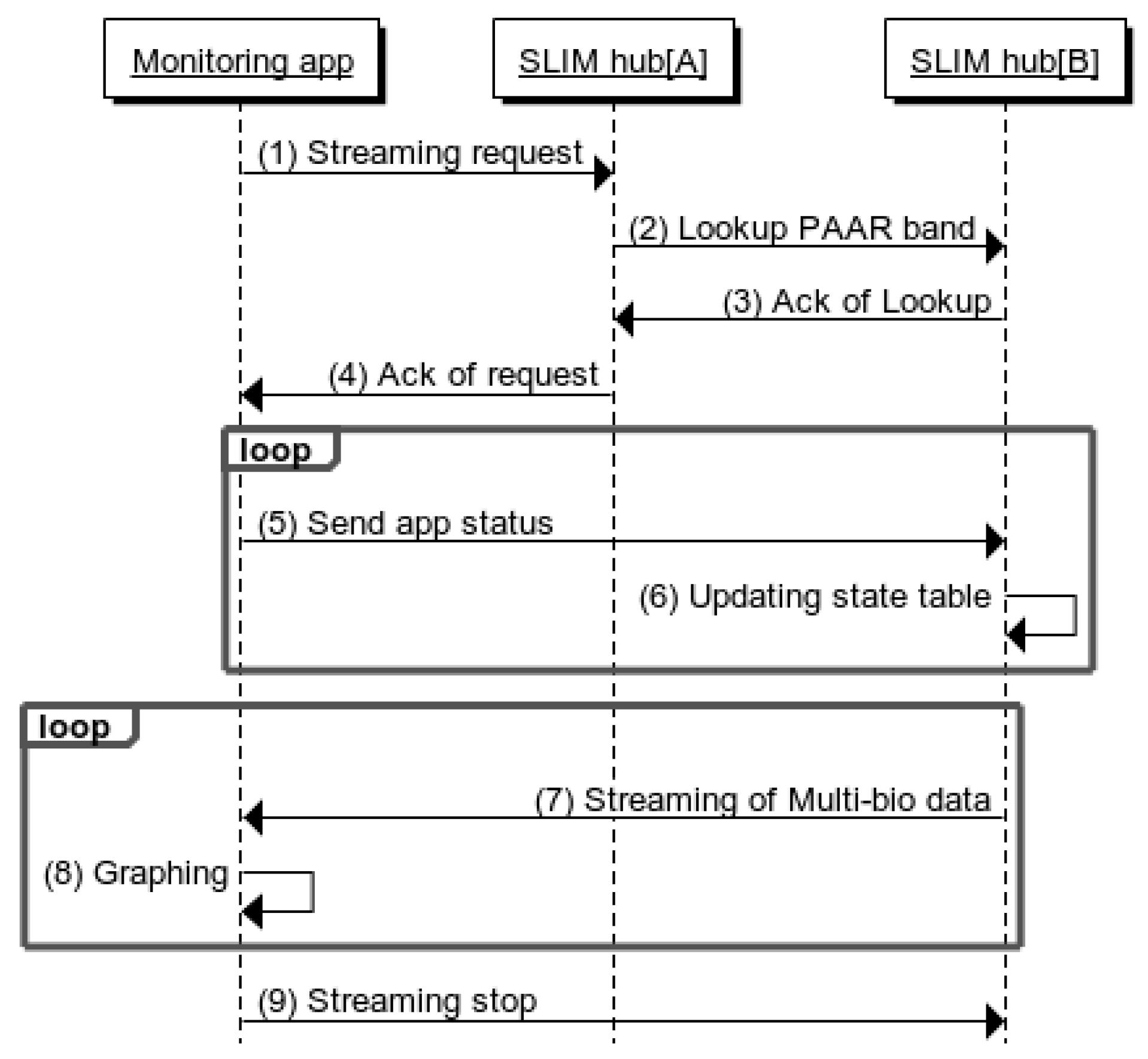
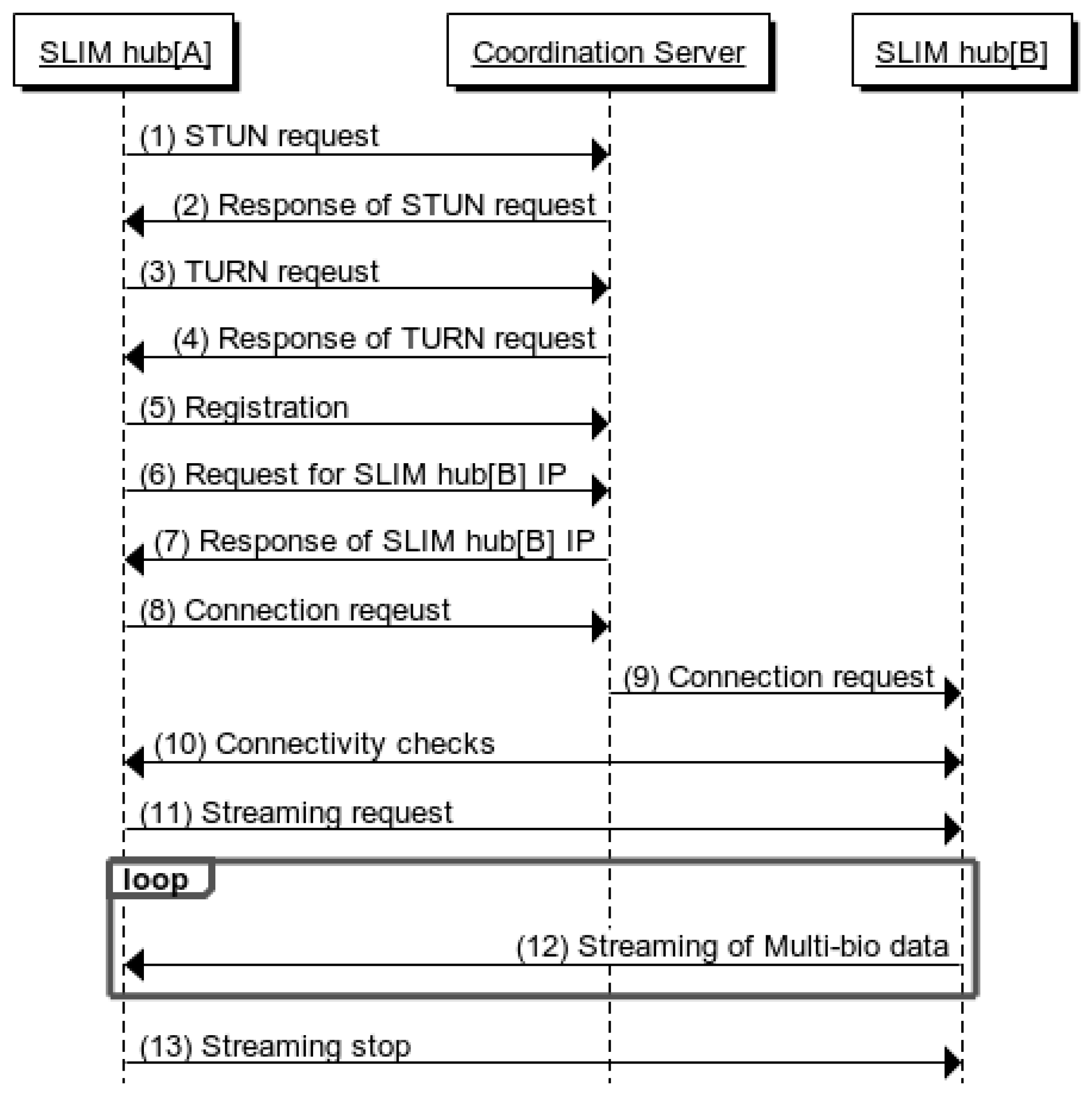
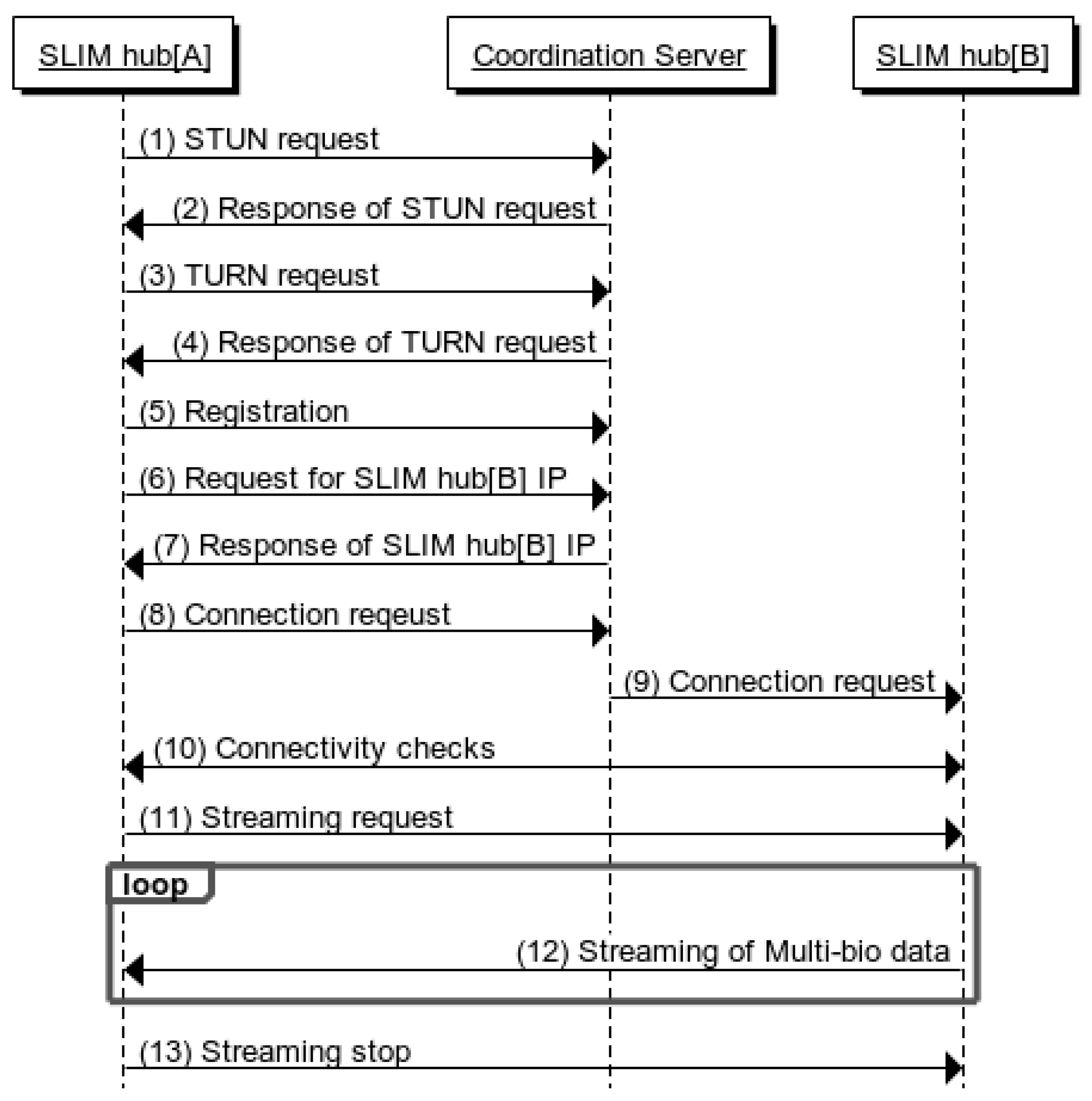
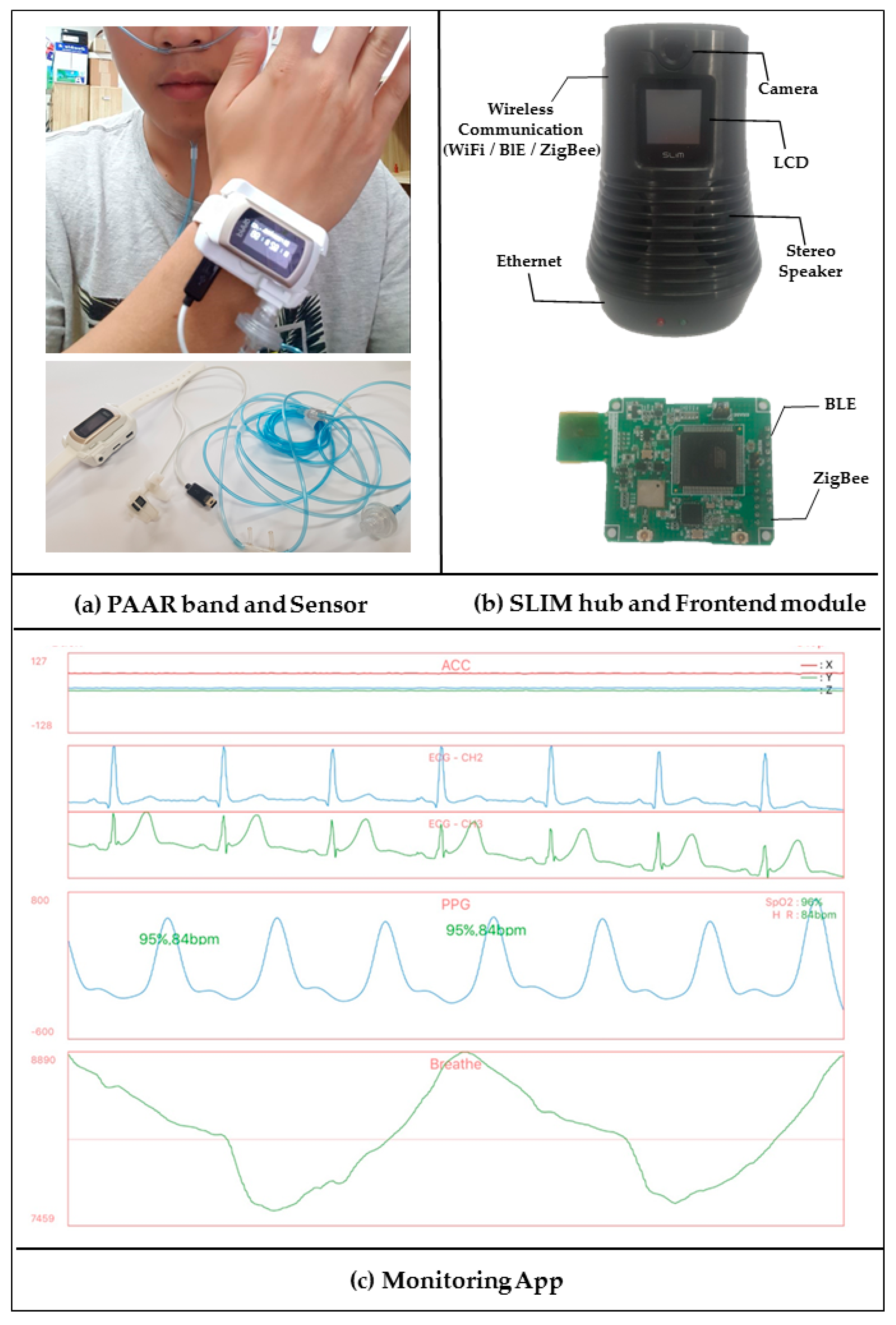
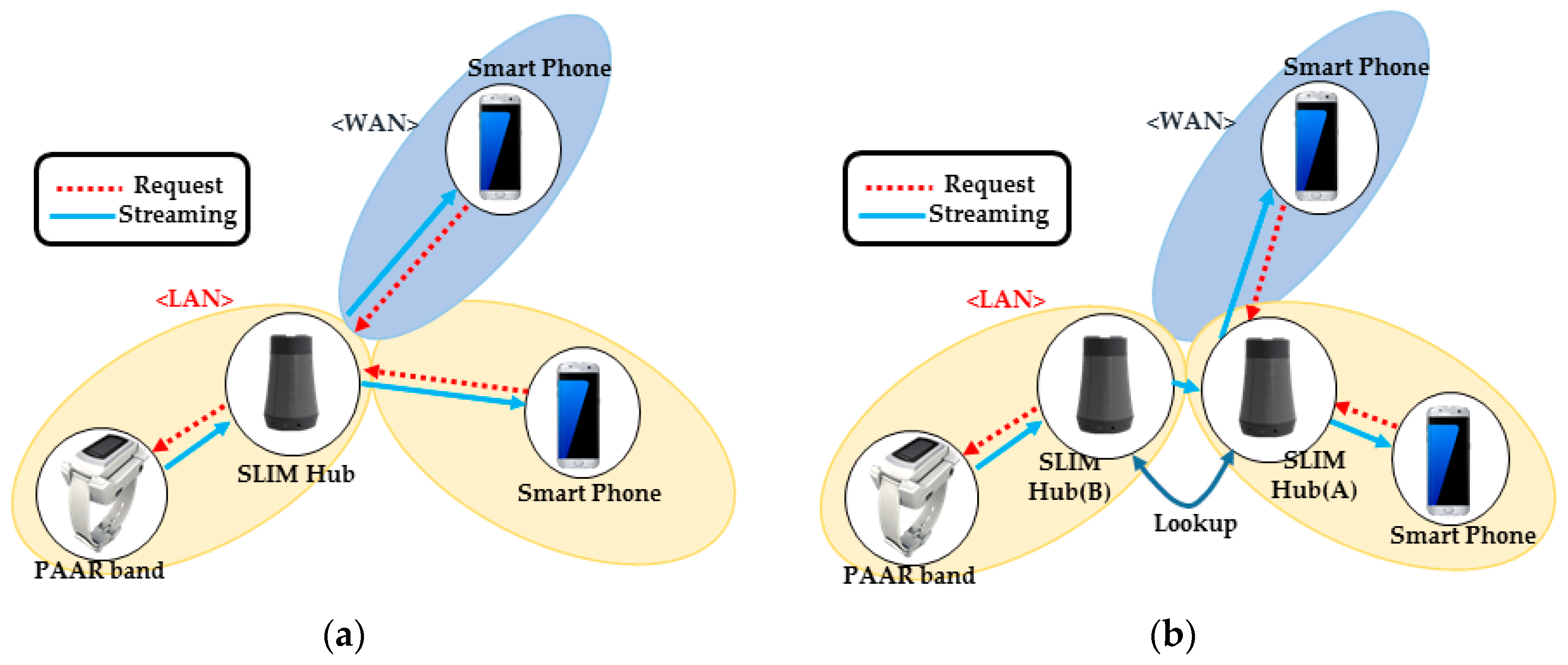


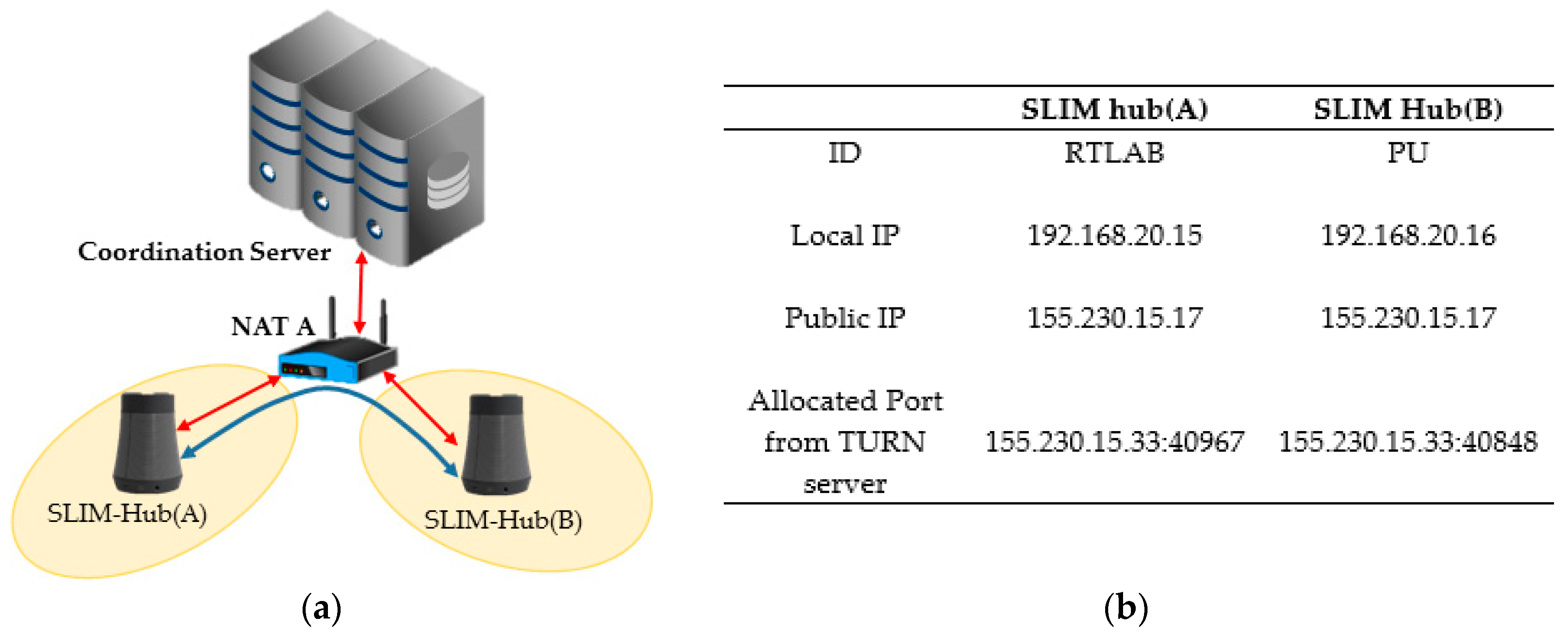
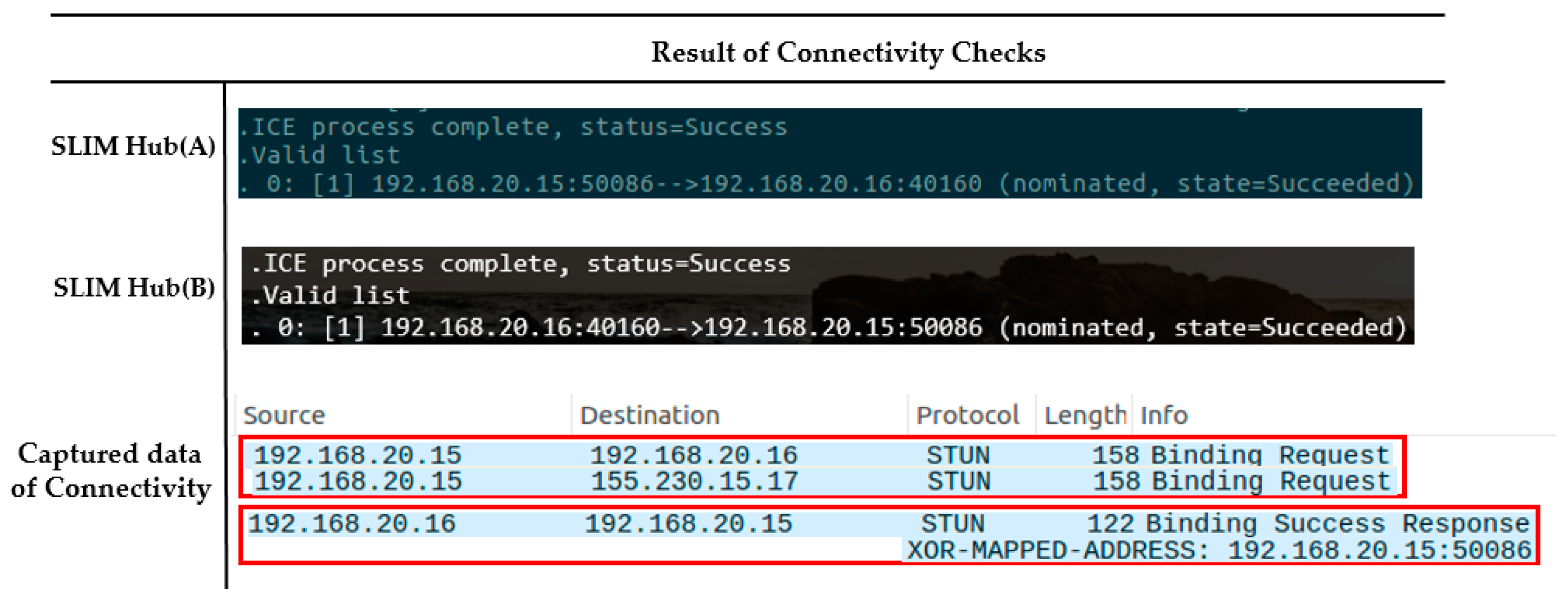
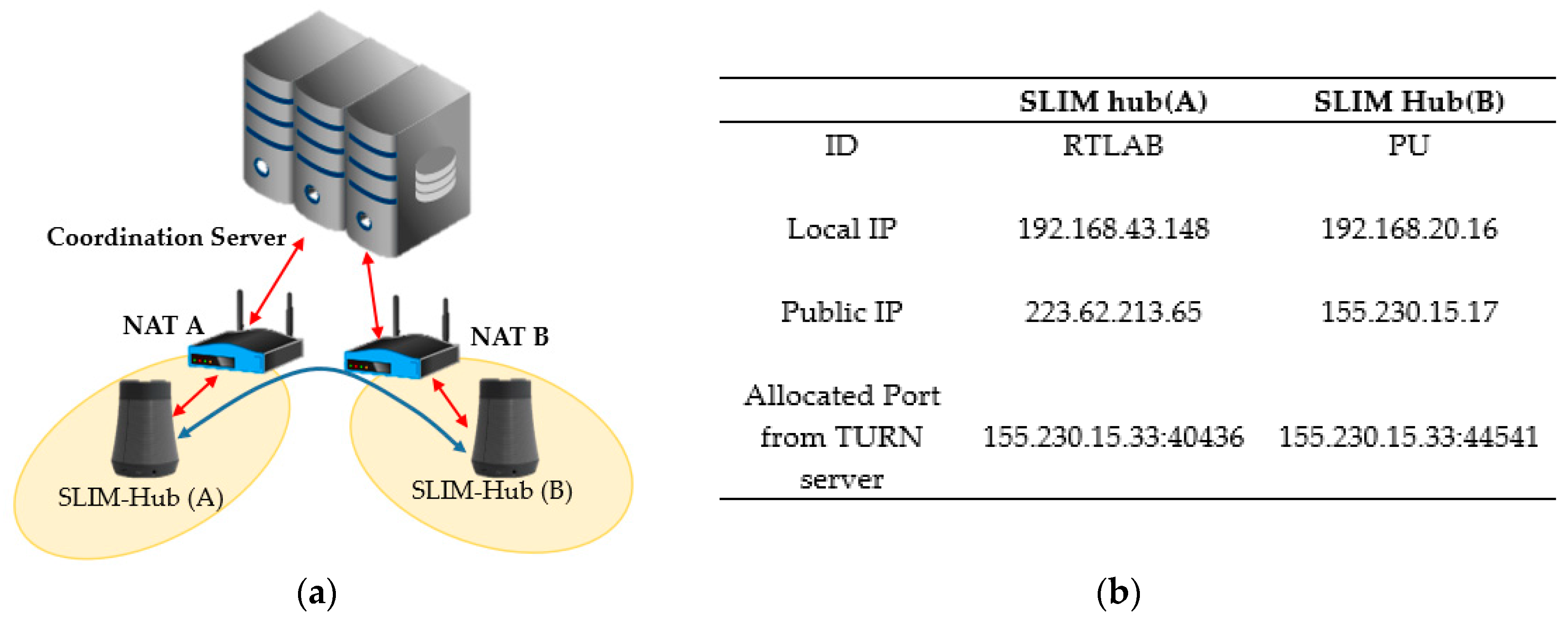
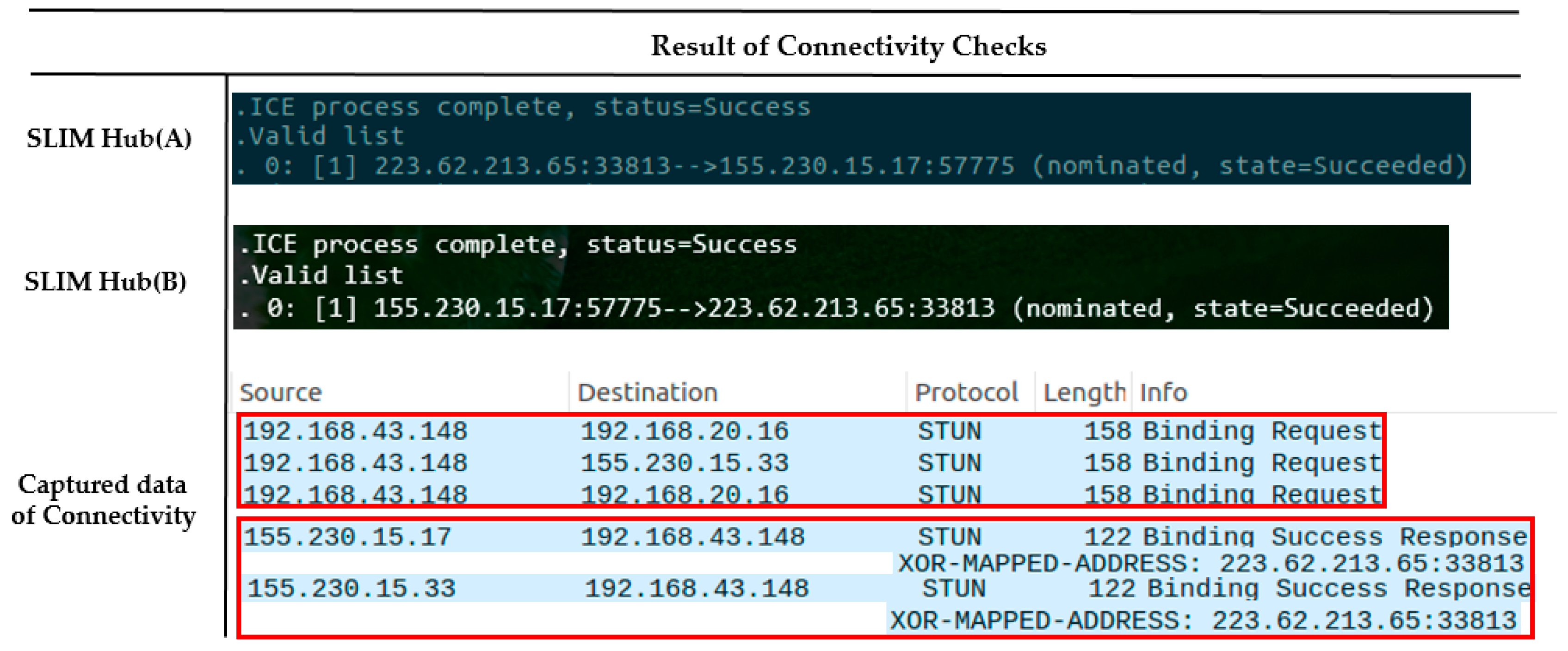
| ID | Local IP | Public IP | Allocated Port from TURN Server | |
|---|---|---|---|---|
| SLIM hub (A) | a1 | 192.168.0.1 | 155.230.a.b | 155.230.y.z:1111 |
| SLIM hub (B) | b1 | 192.168.0.2 | 155.230.c.d | 155.230.y.z:2222 |
| Number of Mobile Device | 1 | 2 | 4 | 6 | 8 | 12 | 16 |
|---|---|---|---|---|---|---|---|
| Average of Jitter (ms) | 39.948 | 39.953 | 39.961 | 39.984 | 39.898 | 39.99 | 39.94 |
© 2017 by the authors. Licensee MDPI, Basel, Switzerland. This article is an open access article distributed under the terms and conditions of the Creative Commons Attribution (CC BY) license (http://creativecommons.org/licenses/by/4.0/).
Share and Cite
Kim, H.H.; Jo, H.G.; Kang, S.J. Self-Organizing Peer-To-Peer Middleware for Healthcare Monitoring in Real-Time. Sensors 2017, 17, 2650. https://doi.org/10.3390/s17112650
Kim HH, Jo HG, Kang SJ. Self-Organizing Peer-To-Peer Middleware for Healthcare Monitoring in Real-Time. Sensors. 2017; 17(11):2650. https://doi.org/10.3390/s17112650
Chicago/Turabian StyleKim, Hyun Ho, Hyeong Gon Jo, and Soon Ju Kang. 2017. "Self-Organizing Peer-To-Peer Middleware for Healthcare Monitoring in Real-Time" Sensors 17, no. 11: 2650. https://doi.org/10.3390/s17112650
APA StyleKim, H. H., Jo, H. G., & Kang, S. J. (2017). Self-Organizing Peer-To-Peer Middleware for Healthcare Monitoring in Real-Time. Sensors, 17(11), 2650. https://doi.org/10.3390/s17112650





